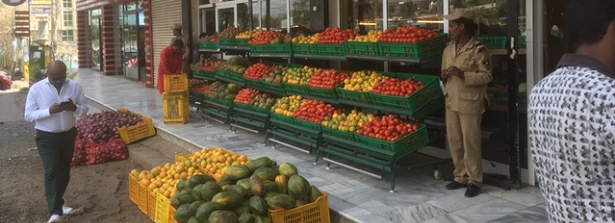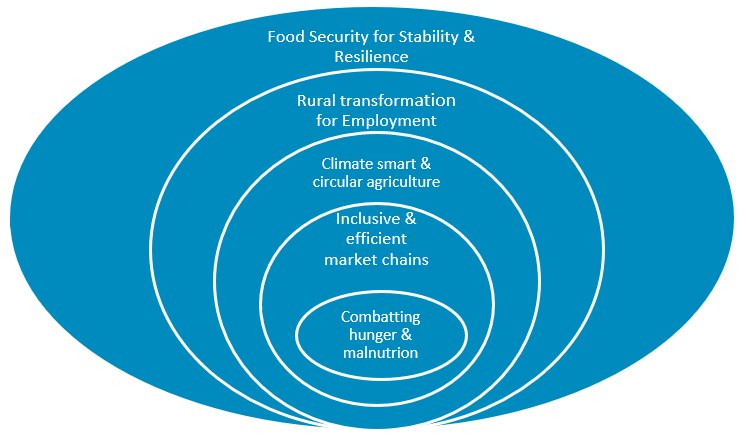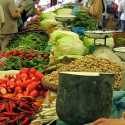Dutch Food Security Policies embrace Food Systems Approach

Dutch food security programs in the international development domain have been mainly focussed during the last few decades on increasing agricultural production and reinforcing international trade of tropical commodities. This focus is now gradually changing towards activities that devote key attention to gender and nutrition, circularity and climate resilience, and upgrading of agro-food value chains. Moreover, there is a growing interest in systematic learning from interventions by engaging researchers into development programs.
There are several drivers that together may explain these positive policy shifts. First, policy letters from Dutch government devote greater attention to investing in global prospects and reinforcing circular and connected agro-food systems, that contribute to innovation processes towards climate-smart farming, inclusive market integration and sustainable value creation. Second, the ’Food for Thought’ report by the Policy & Operations department (IOB) that reviewed experiences in food security programs of the Ministry of Foreign Affairs encouraged to strive for more concrete results in field of reducing malnutrition by using an integrated food systems approach. Third, here is a growing (inter)national recognition regarding the urgency to engage in concerted action against hunger and climate change in order to be able to reach the SDG goals within the time frames agreed upon. Hunger in the world is increasing again and temperatures are rising, and therefore we need to accelerate efforts toward Zero Hunger as well as to increase the effectiveness of interventions.
The profile of the new Dutch policies on food and nutrition security is outlined in five priority themes that together shape the food system transition:
- Combatting hunger and malnutrition
- Inclusive and efficient agro-food markets and value chains
- Climate-smart and circular agriculture
- Rural transformation for employment and income creation
- Food security for stability and resilience
These themes are well chosen and are also based on available Dutch expertise and experience from agribusiness and knowledge and innovation centres. More importantly, outcomes and results in each of these areas require efforts and interventions in other fields and therefore a clear sequence of key activities can be identified depending on local priorities and circumstances.
These policy priorities are also embedded in wider transitions that take place in society. The large imbalance between the rapid changes in demographic growth and population (urbanization) and nutrition (diets) are not accompanied by similar transitions in agro-food systems. In most developing countries, drivers for shifting to climate-smart production systems and nutrition-sensitive supply chains are largely absent. Development programs should therefore principally focus on improving interactions between different levels and layers of the food system (see Figure). That will create incentives for sustained adoption of improved practices and increase responsiveness to markets and information.

The nested nature of these 5 food security themes becomes clear when we look at their mutual relationships (see Figure) and especially when we assess different strategies that are available for contributing to them. For example, there is quite some evidence that direct reduction of hunger (theme 1) can be best reached through unconditional cash transfers to poor women (theme 4), fortification of food transfers (theme 2), investments into climate-smart home gardening (theme 3), and better public provision of drinking water and hygiene (theme 5). This implies that results at individual and household level (less hunger) ask for interventions at market, village, landscape and even regional level.
In a similar vein, we can argue that the reduction of post-harvest losses in food value chains (theme 2) already requires interventions for improved sorting and packaging at farm level (theme 3), asks for investments in labour-intensive processing and handling practices (theme 4) and pay-offs in more stable and resilient food supply (theme 5) and improved food safety (theme 1). Since the results of post-harvest management efforts are mostly received at the very end of the supply chain (less losses, longer shelf-life) but most investments have to be made at upstream levels, some type of stakeholder cooperation between farmers, traders en retailers should be in place. This means that technical innovations and institutional organization need to go hand in hand.
In both examples, it is important to acknowledge that also improvements in the food environment (such as water provision, market logistics) are required to address the problems. For the selection and design of appropriate projects it is of vital important to recognize how interactions and feedbacks between these themes work. Interventions that are based on a food systems perspective might select incentives and innovations that are linked to the perceived outcome but not too close to the problem area. Many well-intended development programs try to ‘fix’ a problem with practical means, but they do not provide a structural solution that is locally embedded and self-enforcing. Using a food systems approach implies that interventions focus on critical themes that influence system performance and these are usually located at other system levels.
Finally, it is worthwhile to emphasize that policy-making from a food systems perspective also implies that ample room is given to learning, experiments and discovery. Since improving food system performance is a non-linear process that looks for optimizing dynamic feedbacks and creating interlinkages, the effectiveness of food systems projects and programs can be strongly enhanced by real-time monitoring and evaluation. This provides insights in the responses of different agro-food system stakeholders and enables to identify binding constraints for food system upgrading.
Real food systems projects are therefore based on a ‘research in development’ strategy that includes an experimental design of interventions (including random variation of activities) and a built-in impact assessment framework that provides accurate information to stakeholders and public authorities regarding the results reached during the implementation process. This enables adaptive management of the program and timely adjustments of the overall strategy. The Dutch government shows real courage to position its food and nutrition strategy as an implementation, innovation and learning agenda.






